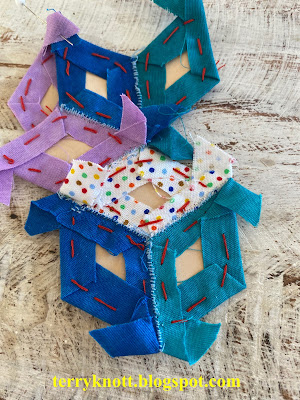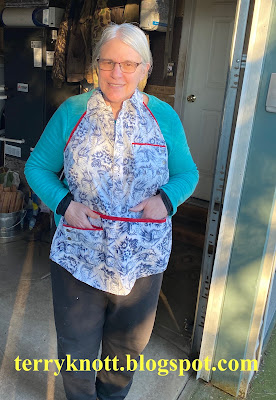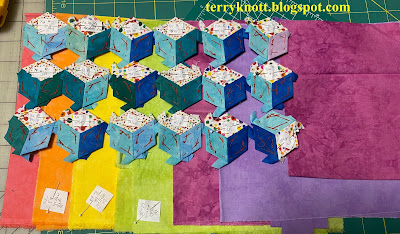 |
| Getting ready to baste |
In reviewing my post from last Sunday, I realized that I hadn't shown the steps in putting the block together. I'll share my process in this post. There are a variety of methods of basting and sewing the blocks together. While I haven't done a lot of English Paper Piecing (EPP) and only a tiny bit of hand piecing, I find the process meditative. I like having a handwork project going. My friend, JoJo, introduced me to EPP. I'm glad that she did!
My die cut paper supplies and template came Paper Pieces. I have no affiliation with the company. I have always had great customer service and my orders have arrived sooner than I had expected.
I start with cutting the shape using a template that is about 3/8 inch larger than the card stock paper. I center the paper on the fabric. Using my nail, I fold the fabric over the edge of the paper. I take a basting stitch in the center of one side. I use a double strand of a strong thread. I leave the knot on the right side of the diamond so that it will be easier to remove when it is time to do so.
 |
| Beginning the basting |
I work my way around the edges of the paper so that the entire section is prepared. Then I begin to stitch the edges together. I use a single thread of 50 wt cotton. I don't match the color because rarely does the thread show. I slide the needle into the edges and let the thread say 'hello' to each side twice. Next, I stitch a
knicker knot at each corner to begin. These knots are surprisingly strong and are not easy to remove. (I know because from time to time, I attach parts in a new pattern!)
I lay the two edges together in a flat orientation. I slide the needle back and forth in a sort of ladder stitch. When I reach the end, I stitch another knicker knot. If I have a lot of thread, I may walk the thread by stitching under the fabric to the next edge. Or, I may slide the thread under the fabric a short distance and tie it off.
 |
| Stitch the edges in a flat orientation |
I continue adding parts until I have constructed the block along with a piece of the background. Then I attach it to the month string. It takes me about an hour and 15 minutes to cut and stitch a section to the chain.
After I had stitched all of January, I put it up on the design wall. What looked great close up, didn't look so great from far away. The value of my background fabric was too close to the value of a number of my temperature fabrics. Now what to do? I wasn't going to rip off all of those background pieces.
Gertie immediate began reiterating that I should've gone with the rainbow background. Again, the variety of fabrics was too chaotic for me. As I pictured the piece on a wall, my eye would look at the background fabrics and not the blocks.
 |
| Back view of the blocks |
As gently as I could manage, I told Gertie that while she had a point, all the fabrics was over the top. Perhaps, though, one fabric would work. That comment caused her stop chirping and start auditioning! She wanted to use the red fabric, it is our favorite color after all. In her words, "One can't go wrong with red." I agree with her there; but, in the end we went with purple.
Gertie asked, "Why purple?" First, the background fabric has no purple in it, it has red, green, yellow and blue. Second, there will be few days that any purple will be used in the project. For sure, there will always be a contrast using it.
This fabric was leftover from last year's temperature quilt project. There isn't enough; but because it is a hand dye fabric from Vicki Welsh, I can confidently order more which I will do. I've had great customer service from Vicki.
 |
| Front view of the blocks |
My plan is to have the previous background become a border which floats into the rows. For the top three and bottom three blocks in each row, I'll use the border fabric as the background. I'll also use the border fabric for the first
three rows and the last three rows. The reason that I chose three is that months less than 31 days will have a spacer block which will be made from the border fabric.
This week, we had a snow day. I can't remember a time when measurable snow fell mid-April. The kids had a snow day off from school and people built many a snowman! My husband said there were six inches at our home. A neighbor about four miles to the east of us had eight inches of snow! The snow was wet and heavy so there was a lot of tree limb damage.
I write this bit about the weather because I chose to not pack any snow fabric for my temperature quilt! I'll "get" to add that diamond and connect the row when I return home.
 |
| Chocolate Easter egg |
This month, I decided that I would sew a block or two to the March row; but, that I would also make a block a day for April. My one monthly goal is to piece all the blocks for February. I've done that but will save that for post number three about this project.
In the meantime, I'm linking to Cynthia at Oh Scrap/Quilting Is More Fun Than Housework.
On Wednesday, I posted about my Ouch quilt. I'm continuing to use Wednesdays as a way to document past Thread Tales or book club quilts.
Finally, happy Easter/happy Passover. May you be enjoying your own traditions today. My daughter introduced me to the tradition of chocolate Easter eggs in the UK for the kids. She has shown me photos of children with boxes of eggs. In the U.S., it is more chocolate bunnies and small brightly foiled covered chocolate eggs.
In the photo, I'm holding a vegan chocolate egg. It is hollow and I'm told that part of the fun is "smashing" it to eat it. I have marveled at the size of the chocolate eggs in the stores as well as the sheer number of available chocolates. I'm fortunate that chocolate isn't a favorite. . .otherwise, I'd be eating way too much of it!!







































